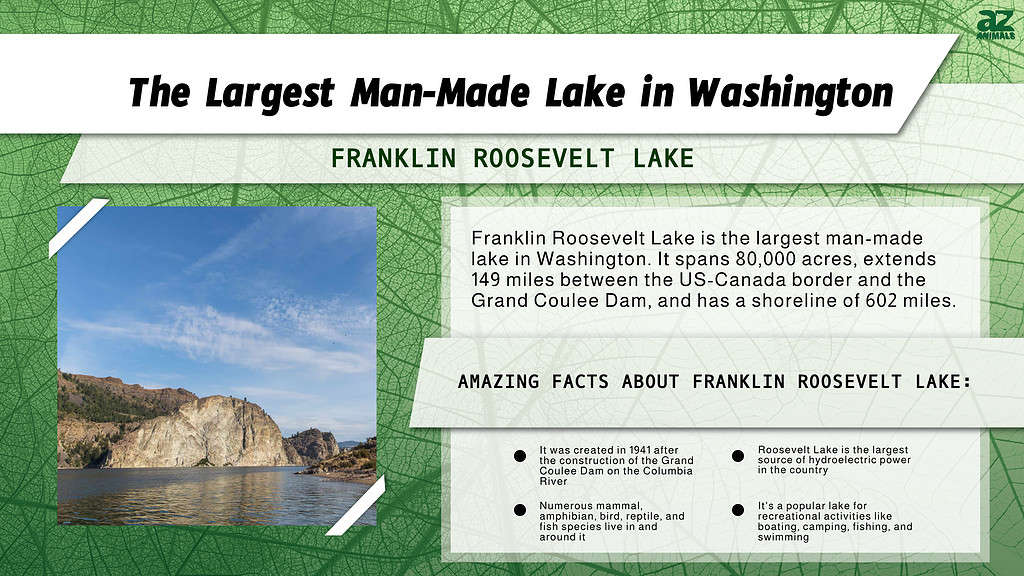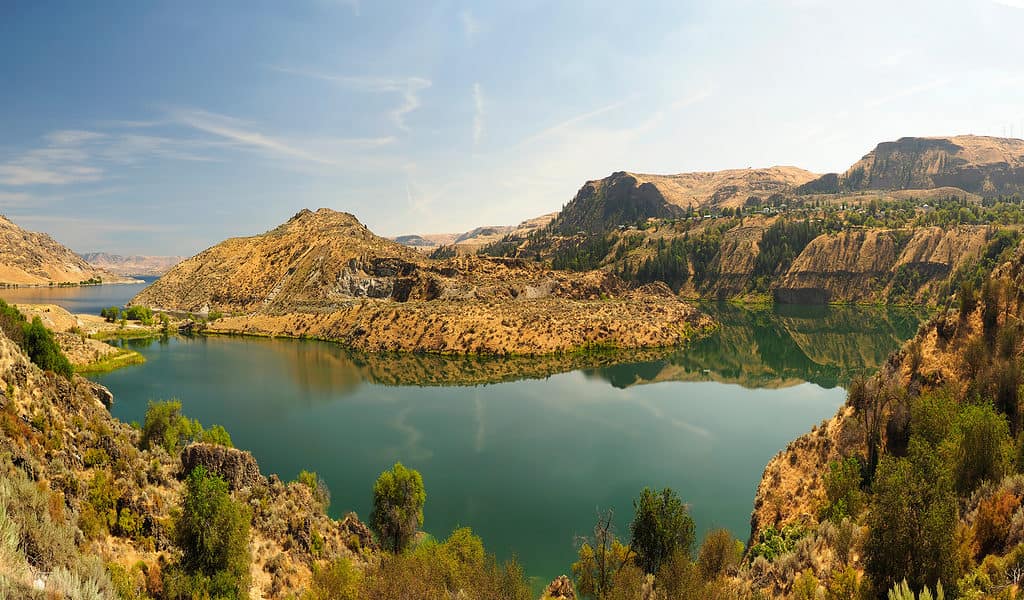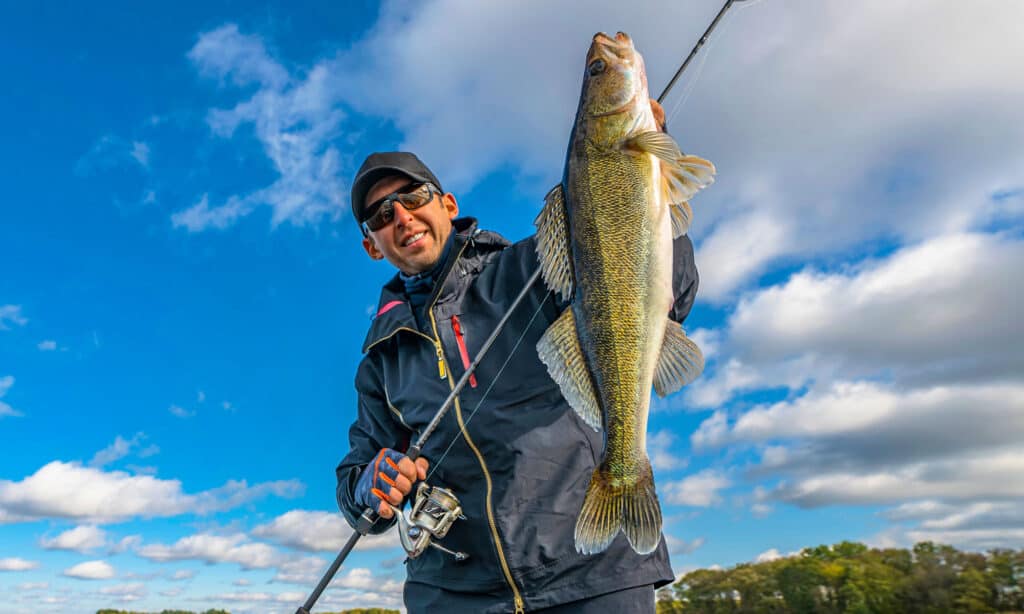The United States has several natural and man-made lakes, and they are located across the 50 states of the country. The state of Washington has 14 man-made lakes. Read on to discover the most interesting facts about the largest man-made lake in Washington.
The Largest Man-Made Lake In Washington

Franklin Roosevelt Lake (formally known as the Columbia Lake or Empire Lake) is the largest man-made lake (reservoir) in Washington and the sixth largest reservoir in the country. It was created in 1941 after the construction of the Grand Coulee Dam on the Columbia River during the tenure of President Franklin Roosevelt, whom the lake was named after.
Roosevelt Lake is the largest source of hydroelectric power in the country. But much more than this, the lake serves several other purposes, including irrigation and water supply. The lake also provides plenty of recreation opportunities and serves as a wildlife habitat. The lake is also the home of the “Lake Roosevelt National Recreation Area” and is controlled by the Bureau of Reclamation.
The size of the lake is approximately 80,000 acres, and it extends over 149 miles between the US-Canada boundary and the Grand Coulee Dam. Its shoreline is about 602 miles, with the capacity to retain about three cubic miles of water. Roosevelt Lake is so big that parts of it can be seen in about five counties in the northeastern part of Washington. These include Ferry County, Lincoln County, Stevens County, Grant County, and Okanogan.
The main source of inflow to Franklin Roosevelt Lake is the Columbia River. However, it also gets water from other rivers, such as the San Poil and Spokane Rivers. The water level in this reservoir fluctuates depending on the season of the year. Franklin Roosevelt Lake supplies water to the Grand Coulee Dam and serves the Lake Roosevelt National Recreation Area as well.
History of the Largest Lake in Washington

The largest reservoir in Washington is Lake Roosevelt.
©Steve Bower/Shutterstock.com
Before a dam was constructed over it, the Columbia River flooded constantly, affecting the lives of Native Americans who lived in the region back in the 1900s. While the main goal of the artificial lake was to protect the residents of Washington, its construction also served an economic purpose because it coincided with the Great Depression.
During this period, the United States faced unemployment and other economic maladies. The then-president, Franklin Roosevelt, created projects to tackle these issues. The construction of the Grand Coulee Dam along the Colombia River was one such project. The aim was to aid the economy, reduce flooding incidences, and serve as a reservoir.
After the dam was completed in 1933, the Bureau of Reclamation named the impoundment behind the dam the Columbia Reservoir. It was also known as the “Empire Lake” in the early years of its completion. Three months after the death of Franklin Roosevelt in 1945, the name of the lake was changed to Franklin Roosevelt Lake in his honor. However, the lake’s surrounding area, like the “Coulee Dam Recreational Area,” was not re-named until 1997.
Wildlife of the Franklin Roosevelt Lake

You can find walleye in Lake Roosevelt.
©FedBul/Shutterstock.com
There are 75 species of mammals, 10 species of amphibians, 200 species of birds, 15 species of reptiles, and 30 species of fish living in Franklin Roosevelt Lake and surrounding areas. The lake is home to diverse fish species like the smallmouth bass, walleye, burbot, bluegill, brook trout, brown trout, kokanee, signal crayfish, and mountain whitefish.
Several large mammals are found in the area around Lake Roosevelt. These animals include black bears, elk, deer, javelins, mountain lions, foxes, and bobcats.
Roosevelt Lake reptiles and amphibians that can be found in the watershed include the bullfrog, bullsnake, western rattlesnake, western toad, Sonoran mud turtles, and various salamanders. Birds like the Canadian geese, songbirds, grebes, snow geese, red-tailed hawks, blackbirds, mallards, and snipes are found at the lake as well.
Roosevelt Lake and the surrounding recreational area are not only home to common animal species but also to some endangered species. These include the bald eagles, Canada lynx, peregrine falcons, gray wolf, woodland caribou, and bull trout.
There are also some animal species in the area that are listed as threatened. Some of them include white sturgeon, Columbia spotted frog, bull trout, Columbia sharp-tailed grouse and ferruginous hawk.
Environmental and Economic Impact of the Largest Man-made Lake in Washington
The Franklin Roosevelt Lake is a man-made lake with an impact on the environment, economy, and people of Washington. Primarily, the lake helps to regulate the water level of the Columbia River to keep it from flooding downstream. The Franklin Roosevelt Lake is also used for irrigation and as a source of water supply to close communities. Water supply from the lake also helps with agricultural activities in the area.
The lake and the area around it also serve as a relaxation center for people. It provides an array of away-from-home adventures with lots of recreational activities such as boating, camping, fishing, and swimming. Recreational activities boost the economy of the locals through tourism. Hydroelectric power from the dam also contributes positively to the local economy.
Additionally, the lake has contributed immensely to the preservation and protection of the local ecosystem in Washington. It is a habitat for different species of fish, birds, reptiles, and mammals. It serves as a safe haven for threatened and endangered species in the state.
Roosevelt Lake also serves as a cultural and historical preservation of the people who lived there before the Grand Coulee Dam was constructed.
Conclusion
The United States has over 53,000 man-made lakes, with beautiful recreation centers to enjoy and experience nature at its finest. Franklin Roosevelt Lake is the largest in the State of Washington and is of economic and ecological significance to the people and wildlife of the state.
Where is Franklin D. Roosevelt Lake Located on a Map?
The Franklin D. Roosevelt Lake is a body of water formed by the Grand Coulee Dam’s blocking of the Columbia River in 1941, situated in Washington state. This reservoir is named in honor of Franklin D. Roosevelt, who was serving as President during the construction of the dam.
Here is Franklin D. Roosevelt Lake on a map:
The photo featured at the top of this post is © iStock.com/MathewHayward
Thank you for reading! Have some feedback for us? Contact the AZ Animals editorial team.






